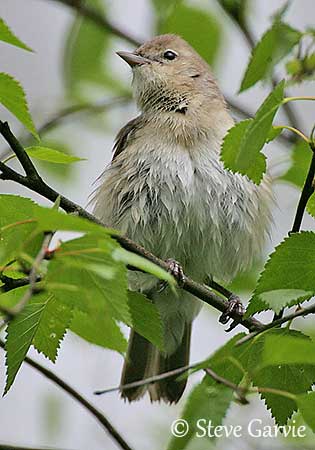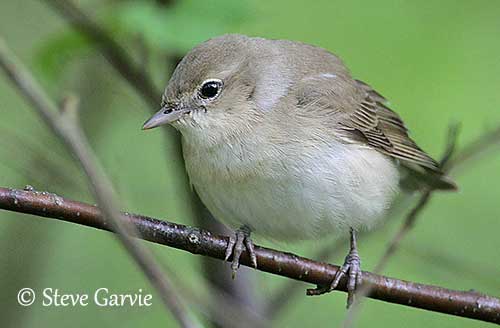
Fr: Fauvette des jardins
Ang: Garden Warbler
All: Gartengrasmücke
Esp: Curruca Mosquitera
Ita: Beccafico
Nd: Tuinfluiter
Sd: trädgårdssångare
Photographers:
José Luis Beamonte
Pájaros de España
Steve Garvie
RAINBIRDER Photo galleries & Flickr Rainbirder
William Price
PBase-tereksandpiper & Flickr William Price
Text by Nicole Bouglouan
Sources:
HANDBOOK OF THE BIRDS OF THE WORLD Vol 11 by Josep del Hoyo, Andrew Elliott and David Christie - Lynx Edicions - ISBN: 849655306X
THE COMPLETE BOOK OF BRITISH BIRDS – Written by “Royal Society for the Protection of Birds” experts - Préface de Magnus Magnusson - Michael Cady- Rob Hume Editors - ISBN: 0749509112
THE HANDBOOK OF BIRD IDENTIFICATION FOR EUROPE AND THE WESTERN PALEARCTIC by Mark Beaman, Steve Madge - C. Helm - ISBN: 0713639601
ENCYCLOPEDIE DES OISEAUX DE FRANCE ET D’EUROPE – de Peter Hayman et Rob Hume - Flammarion – ISBN : 2082009920
BIRDS OF AFRICA SOUTH OF THE SAHARA by Ian Sinclair and Peter Ryan - Princeton University Press Princeton and Oxford - ISBN: 0691118159
BIRDS OF THE MIDDLE EAST by R.F. Porter, S. Christensen, P Schiermacker-Ansen C.Helm - ISBN: 0713670169
Wikipedia, the free encyclopaedia
What Bird-The ultimate Bird Guide (Mitchell Waite)
Pájaros de España (JL Beamonte)
Biodiversity Explorer – The Web of Life in Southern Africa
The British Birds – Birds from Great Britain
Garden Warbler
Sylvia borin
Passeriformes Order – Sylviidae Family
INTRODUCTION:
The Garden Warbler is a plump, drab greyish to olive-brown warbler without distinctive or outstanding features other than a beautiful voice. When in full song, it has few rivals. The song is melodious, sweet and sustained, very similar to some song types of Blackcap.
The Garden Warbler breeds in Europe and spends the winter in sub-Saharan Africa. It frequents dense vegetated areas and woodlands, shrubbery and bushy heathland. It is rather secretive and usually keeps well hidden within the vegetation.
This species is common in suitable habitats, and even widespread throughout most of breeding range. It is not currently threatened.

DESCRIPTION OF THE BIRD:
Biometrics:
Length: 14 cm
Wingspan: 20-24 cm
Weight: 16-22 g
The Garden Warbler has greyish-brown to olivaceous upperparts with diffuse grey wash on neck sides, forming an indistinct grey half collar. The underparts are whitish with pale buff tinge on chin and throat.
We can see a pale supercilium and a conspicuous white eyering around the dark brown eyes. The relatively short bill is brown with pale base. Legs and feet are greyish-brown.
The Garden Warbler is a plump passerine with fairly rounded head, rather long, pointed wings and square-ended tail. Male and female are similar.
The juvenile resembles adult. In autumn, the first year in fresh plumage is more olive and buff overall.
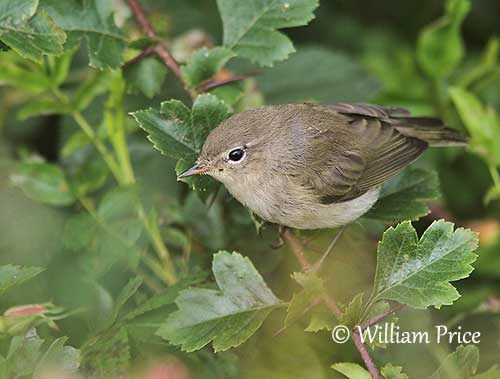
SUBSPECIES AND RANGE:
The Garden Warbler has two subspecies.
S.b. borin breeds in Europe E to Finland, C Poland, W Hungary and C former Yugoslavia. Outside breeding season, it winters in sub-Saharan Africa.
S.b. woodwardi breeds from C Poland, former Yugoslavia and Bulgaria, E to C Siberia (upper R Yenisey). It winters in E and S Africa.
This race is paler and greyer than nominate, and lacks cream or buff tinge.
HABITAT:
The Garden Warbler breeds in broadleaved and mixed woodlands with shrubbery, dense bushes, woodland fringes, bushy heathland, parks and large gardens. It usually avoids pure coniferous plantations.
During winter in Africa, it can be found in woods, at forest edges, in orchards and gardens. It also frequents savanna and dry areas with dense vegetation, and woodlands. It often prefers low elevation habitats.
The race “woodwardi” prefers drier areas in S Africa, whereas nominate race frequents more humid and rainy zones.
CALLS AND SONGS: SOUNDS BY XENO-CANTO
The Garden Warbler sings from the vegetal cover, perched in tree or bush, and more rarely in flight. The usual call is a repeated, harsh “chek-chek” and the alarm call includes “wet” and duij” notes more or less repeated depending on degree of threat.
The song is rich, sweet and sustained, very similar to some song types of Blackcap, but the full song is much longer, quicker and more monotonous. It is mostly a musical warbling with distinct thrush-like tonality, but lacking the ascending fluty finish of this close species.
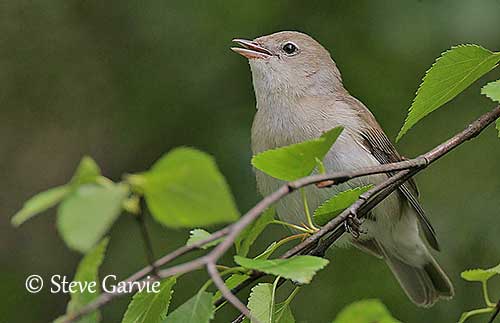
BEHAVIOUR IN THE WILD:
The Garden Warbler feeds on various invertebrates including caterpillars, flies, larvae, spiders and worms, mainly during the breeding season. It is mostly frugivorous in autumn, often feeding on berries and fruits.
On the wintering grounds, it feeds on fruits of several plant species, but when berries become scarce, it feeds mainly on insects. During the spring migration, it often consumes pollen and nectar of succulent plants of genera Aloe, Acer and Brassica.
It forages by gleaning prey from vegetation, especially from foliage and twigs. It rarely chases insects in flight. It feeds usually below six metres, but occasionally in canopy of tall trees according to food availability.
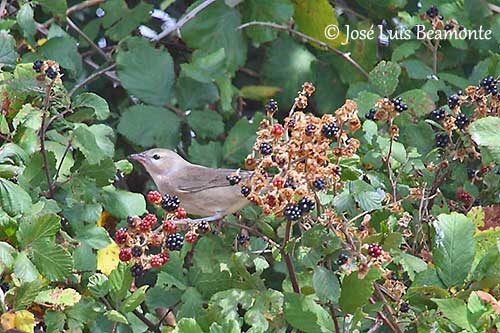
The Garden Warbler is usually monogamous during the breeding season. It nests solitary and is territorial during this period. While displaying, the male starts with rapid beating of wings. Then, it approaches and stands alongside the female, and beats only the wing on side facing her.
The male often builds several nests and the female chooses one and completes it. But both mates can also build a new nest together.
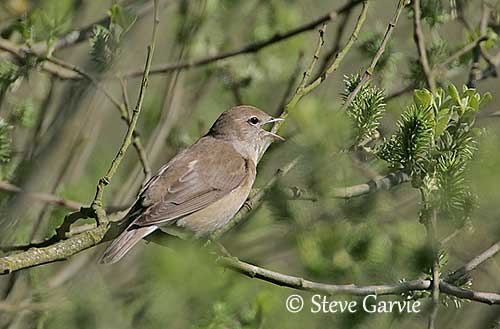
The Garden Warbler is a long-distance migrant. The adults leave the breeding grounds from late July, before the juveniles. There are probably different migration stages in Africa, with a first influx in mid-October and the second from December.
The return migration occurs from late February, with peak from late March to late April. This species exhibits site fidelity both at stopovers and wintering areas.
The Garden Warbler in flight alternates several wingbeats with short glides.
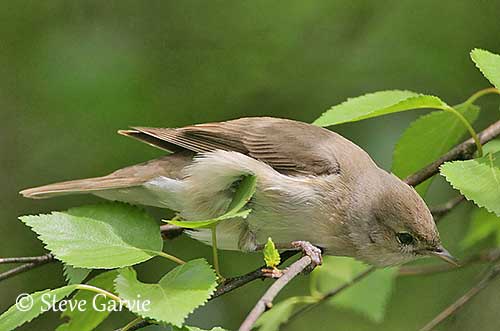
REPRODUCTION OF THIS SPECIES:
The breeding season takes place between April and July. The nest is selected by the female or a new nest is built by both adults. It is a cup-shaped structure made with grass, leaves and roots. The cup is lined with softer grasses and hairs. It is usually placed low down in small tree or bush (bramble) or among tall plants.
The female lays 4-5 whitish eggs with olive-brown markings. Both adults share the incubation during 11-13 days. The young are fed by both parents. They leave the nest 10 days after hatching, and they are independent 10-14 days after fledging. This species may produce two broods per season.
Some nests are sometimes parasitized by the Common Cuckoo.
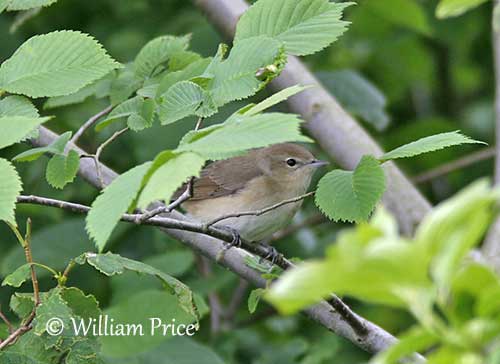
PROTECTION / THREATS / STATUS:
The Garden Warbler is usually common in suitable habitats, and the species is widespread in most parts of the breeding range.
A very preliminary estimate of the global population size is 54/124 million individuals, but further validation is needed. The European breeding population is estimated at more than 17,000,000 pairs. The population is considered stable in some countries of C and N Europe. This species has benefited from forest fragmentation and land-use changes in N Europe.
The Garden Warbler is currently evaluated as Least Concern.
